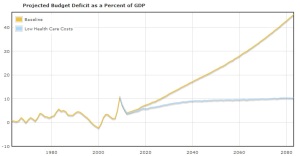From the Center for Economic and Policy Research:
The U.S. health care system is possibly the most inefficient in the world: We spend twice as much per person on health care as other advanced countries, but we have worse health outcomes, including a lower life expectancy. The government, through programs like Medicare and Medicaid, pays for approximately half of the country’s health care, almost all of which is actually provided by the private sector. Thus, the bulk of our projected rising budget deficits are due to skyrocketing health care costs.
The CEPR Health Care Budget Deficit Calculator shows that if the U.S. can get health care costs under control, our budget deficits will not rise uncontrollably in the future. But if we fail to contain health care costs, then it will be almost impossible to prevent exploding future budget deficits.
The Calculator lets you see what projected U.S. budget deficits would be if we had the same per person health care costs as any of the countries listed below, all of which enjoy longer life expectancies than the U.S. (Life expectancies are listed in parentheses.)
The yellow line shows projected deficits based on baseline projections from the non-partisan Congressional Budget Office (CBO). The blue line shows where the deficits would be if health care costs in the U.S. were to rise only due to the aging of the population and stay even with per capita GDP growth (based on CBO’s “Low Health Care Cost” projection).
More To Read
May 2, 2024
Baby Bonds: A Step Toward Racial and Economic Equity
The Washington Future Fund would bring this innovative, anti-racist policy to the Evergreen State
May 1, 2024
Laws Targeting LGBTQ Youth Aren’t Just Bad for Kids – They’re Bad For The Economy
The harm done by anti-LGBTQ laws expands so much further than queer children and teens
April 26, 2024
What is WA Cares and Why Does It Matter for Washingtonians?
We need to defend this important policy from billionaires looking to save a buck

